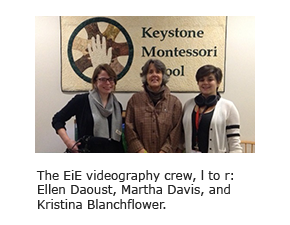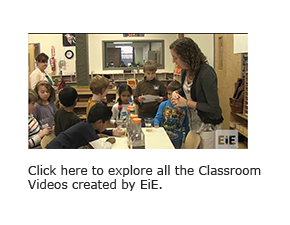Guest blogger Martha Davis is EiE’s multimedia project manager.
Over the past three years, with support from Cognizant, EiE has been developing an online library of short videos. This library includes a set of “EiE Classroom Videos,” which feature candid footage of skilled teachers facilitating the four lessons in an EiE unit. 
To shoot these videos, I’ve been spending lots of time in elementary school classrooms. At first, it’s like visiting another country. There are new traditions and new words getting thrown around and you feel like an outsider. But after a couple of hours you’re in the swing of things and you’re absorbing some of this culture. After a day or two, you’re singing the songs and pulling out your lunch right along with all of the other kids in the class. Before you know it, you’ve adopted all of their classroom culture.
It has been a huge privilege to be invited to join so many classrooms for hours at a time, days in a row. In the course of my career, I’ve conducted many classroom observations, typically one-hour visits to collect data for educational research or curriculum development projects. But the opportunity to observe a classroom for a full week, to watch a teacher integrate all four lessons of an EiE unit, has been a unique experience.
When our team first sets up our cameras, the teachers are nervous, the kids are nervous, and I’m nervous! We do capture great moments that first day . . . but the third, fourth, and fifth days are even better because everyone is comfortable having us in the room.
One thing that becomes clear with extended observation is how each teacher builds his or her own unique learning environment, where students strongly identify as part of the group and have shared cultural norms around behavior, work ethics, and so on.
When I’m filming an entire EiE unit, I am able to watch teachers as they help their students develop not just a knowledge of facts, but another kind of intelligence, what we call “engineering habits of mind.” For example, one of the teachers featured in our videos, Julie Mock of Lake Elmo Elementary School in Minnesota, always has her students work in teams and reinforces the benefits of collaborative work. She’ll ask a student, “Have you shared your ideas with your team?” or ask a group, “Do you all agree? Have you talked about this?” Over the course of filming, I could really see the cumulative effect of this type of teacher support: children readily shared their ideas with each other and instead of working competitively, they focused on building consensus.
Extended observations also helped me see how another teacher featured in our Classroom Videos, Jean Facchiano at the Silva Elementary School in Fall River, MA, builds the habit of mind we call “agency.” Specifically, she helps her students to see themselves as capable engineers. As she guided her students through EiE’s unit, “A Long Way Down: Designing Parachutes,” I heard her address her students over and over again as “aerospace engineers,” or tell them, “You engineered a great solution. You should just go get a job as an engineer!”
Of course I’ve heard many teachers make these kinds of supportive comments: “I know you can do it!” or, “Great idea! I never would have thought of that!” This consistent encouragement develops two other engineering habits of mind: 1) being persistent, and 2) learning from failure. When a teacher creates a safe environment for children to share innovative ideas and acknowledge failure as part of the learning experience, this positive framework impacts how well kids do in school . . . and whether they want to stay in school.
Educators who watch our videos tell us how much they appreciate these “windows” into other classrooms. They also say that the videos “demystify” the teaching of engineering. We hear teachers say things like, “I got some really good ideas from your windmills teacher,” or “The maglev teacher is so entertaining, I loved watching her.”
America’s public schools are just that—supported by the general public. But most taxpayers never get to see, as we have, what actually happens, day after day, in an elementary school classroom. I think most people’s understanding what it’s like to be an elementary student is framed mostly by decades-old memories of their own school experiences. It’s hard to appreciate the complex work that today’s teachers do.
I want to send out a huge thank you to the teachers, students, and parents who have allowed us to capture the candid moments you see in our Classroom Videos. By allowing us to enter their classrooms, they offered us a unique opportunity to observe the process of teaching—and more importantly, a way to share that process with others who want to learn what it looks like when young children engineer.








